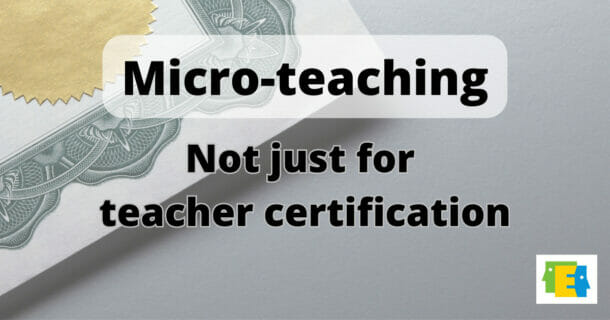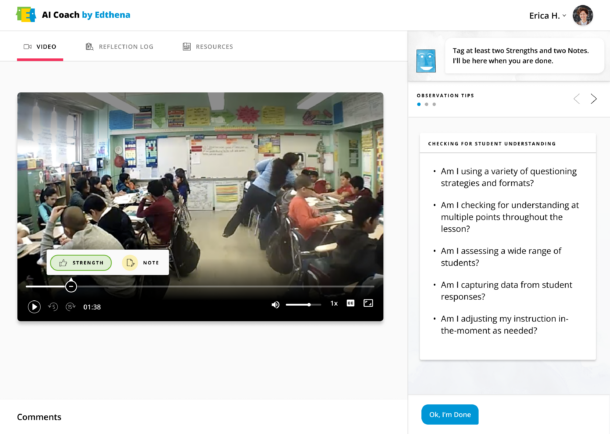Visible Learning Research Proves Micro-Teaching Works. Try It These 2 Ways

The number of different strategies suggested to school leaders for impacting student learning is immense. It’s hard to know what actually works and which instructional techniques are worth implementing.
Micro-teaching has one of the highest measured impacts on improving teachers’ practice for stronger student achievement, according to John Hattie’s Visible Learning research.
As an instructional coach, professional development coordinator, or school leader, implementing micro-teaching with a structured process is a proven way to support teacher improvement.
This blog post outlines what you need to consider for effective micro-teaching, as well as two concrete ways to implement this research-backed technique.
Keep reading to learn more about implementing micro-teaching and technology solutions to make the process easier.
Planning micro-teaching at your school? Remember to think about these things
In Visible Learning, education researcher John Hattie conducted a meta-analysis of over 50,000 studies on the various influences on student achievement.
Micro-teaching (video review of lessons) was one of the highest-impact strategies for influencing student achievement among the more than 250 strategies included in the 2018 Visible Learning analysis.
The micro-teaching technique, sometimes written microteaching, involves recording a small segment of teaching, perhaps with a small group of students, other teachers, or even practicing independently. Teachers analyze the short teaching video using a structured reflection protocol.
Micro-teaching supports teachers’ work to improve identified growth areas and try new classroom strategies.
It’s a simple concept, but micro-teaching requires a plan to be successful.
School administrators implementing micro-teaching need to consider how they will concretely plan and provide structures for:
- What and how much teachers should record? A video as short as 90 seconds can be helpful in the right contexts. Or, teachers can record longer segments in the range of 3-7 minutes. But keep the video short and focused for this type of learning.
- What reflection protocol do teachers utilize to analyze their video? For example, are there skill-aligned video reflection and analysis questions teachers should ask themselves? It’s helpful to have a place to store reflection notes for future goal-setting.
- How will the videos be shared, if at all? Teachers might collaborate to analyze teaching videos or work independently. Ensure teachers have a safe place to store videos with sensitive classroom information.
Below we’ve described two ways school or PD leaders can implement micro-teaching that address all of the teacher needs above.
Idea 1: Implement micro-teaching in teachers’ PLC structure for evidence-based collaboration
One collaborative method of micro-teaching is to implement it within a Professional Learning Community (PLC) structure: multiple teachers in a PLC group record themselves teaching the same topic with a small group of students.
Start by asking teachers to record a 5- to 7-minute mini lesson. Consider what the videos should have in common and provide direction. For example, maybe the goal is to examine the questions used to elicit student thinking. Or maybe the focus will be on introduction to new material.
Then, teachers share and review those videos with each other, able to compare their individual examples of instruction among their colleagues. Consider what reflection questions you would want them to answer about themselves and provide those in advance.
In addition to their own self-reflection, consider how you want teachers to give feedback to each other. For example, some facilitators may value teachers giving each other positive praise, but this can also limit the ability to be a critical friend about what is happening in each others’ classrooms.
The collaborative discussion around teaching best practices during PLC time helps teachers identify areas for growth and contributes to collective teacher efficacy, another high-impact lever according to the Visible Learning research.
Having a structure for safely storing and sharing classroom videos is key to this method of micro-teaching.
School administrators need to ensure teachers and coaches have a way to capture and sort through feedback that is aligned with schoolwide instructional priorities in order for micro-teaching to be effective.
Idea 2: Implement micro-teaching to improve Intro to New Material before teaching it to students
A different way to implement micro-teaching with teachers takes the form of independent pre-teaching.
For this method, ask teachers to record 90 seconds to 3 minutes as they pre-teach the core idea of an upcoming lesson two days prior to delivering the introduction to new material as part of a lesson.
The key is to prompt teachers to capture the core idea that will be crucial to present clearly to students. Maybe this is a specific math problem that everything hinges on or the mental model students will be using.
As teachers review and analyze their pre-teaching video independently, they can identify ambiguities of the core idea and ways to sharpen it when actually delivering the content.
Teachers reflecting on their own pre-teaching video answer questions such as, “In what ways am I activating students’ background knowledge?” or “Could this example create any confusion for students?”
This reflection can be particularly helpful before introducing a new topic to ensure that the examples are as clear as they seem when put into a lesson plan.
Just like with using micro-teaching as part of a PLC learning experience, teachers implementing this style of micro-teaching also need a way to capture their reflection work and school leaders need to intentionally follow up with teachers about their learning.
In particular, consider asking teachers what changes they will make to the upcoming lessons based on the micro-teaching analysis.
As an administrator or instructional coach looking to implement micro-teaching, it’s important to set aside the time to make this plan for helping teachers be successful and also give them the tools they need to analyze their videos in a secure way.
Asking teachers to record a 90-second segment sounds simple but school administrators should remember that a structured process is key to micro-teaching success.
How technology can support efficient micro-teaching implementation
School administrators who help coordinate video evidence-based micro-teaching need a system that doesn’t necessitate logistical gymnastics for those participating.
But, spoiler alert, “Put it on YouTube” is not an effective solution for capturing and safely handling classroom videos. And communicating your reflection protocols also needs a clear system to stay organized.
Here at Edthena, we have two platforms that provide the technology for supporting and enabling micro-teaching (and other types of video learning).
Edthena Video Coaching
If you want your teachers to work collaboratively, the Edthena Video Coaching platform makes it easy to share videos, seek and provide feedback, and tag specific moments of instructional skills.
After recording a mini lesson, teachers upload their video to the platform and securely share it with a group of peers, such as in their PLC. Reviewing different teachers’ videos is easier for collaborators because everything is in one place and can be viewed asynchronously in advance of coming together. This ensures that in-person time is more productive.
Edthena Video Coaching also has built-in tools for you to design teachers’ reflection protocols.
AI Coach by Edthena
AI Coach by Edthena is a platform designed to support independent reflection for teachers on their classroom videos by giving them a built-in protocol for the structured reflection process.
Within the AI Coach platform, teachers navigate a fully-supported reflection protocol guided by a virtual coach. Throughout the process, they can access customized video observation tips on skills like clearly presenting academic content.
The AI Coach platform also provides teachers a structure for creating a plan for classroom action steps. For instructional coaches and school leaders, there’s a dashboard to understand teachers’ progress in completing cycles of independent micro-teaching.
For busy school leaders and instructional coaches, AI Coach helps you implement professional learning like micro-teaching without any extra effort or planning from you.
Micro-teaching is an effective way for teachers to have an impact on student learning
Micro-teaching, review of short teaching videos, is one of the research-proven highest-impact ways for teachers to have an effect on student achievement.
The key to successful micro-teaching at a school requires structures and processes for teachers to effectively reflect on and improve their instructional practices.
We’re living in a world full of video within easy reach now, so consider what structures would help your teachers try micro-teaching with more support.

